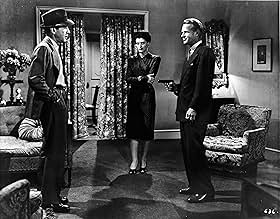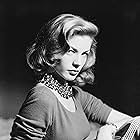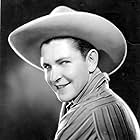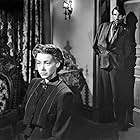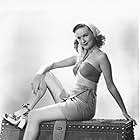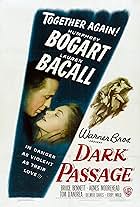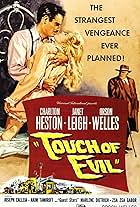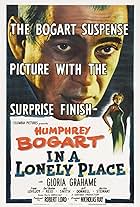Private detective Philip Marlowe is hired by a wealthy family. Before the complex case is over, he's seen murder, blackmail--and what might be love.Private detective Philip Marlowe is hired by a wealthy family. Before the complex case is over, he's seen murder, blackmail--and what might be love.Private detective Philip Marlowe is hired by a wealthy family. Before the complex case is over, he's seen murder, blackmail--and what might be love.
- Awards
- 2 wins
Trevor Bardette
- Art Huck
- (uncredited)
Joy Barlow
- Taxi Driver
- (uncredited)
Max Barwyn
- Max
- (uncredited)
Deannie Best
- Waitress
- (uncredited)
William A. Boardway
- Casino Patron
- (uncredited)
Tanis Chandler
- Waitress
- (uncredited)
Storyline
Did you know
- TriviaDue to Humphrey Bogart's affair with co-star Lauren Bacall, his marital problems escalated during filming, and his drinking often resulted in his being unable to work. Three months after the film was finished, Bacall and Bogart were married.
- GoofsAfter finding a corpse at the Geiger house, Marlowe gets his fingerprints on nearly everything.
- Quotes
Philip Marlowe: She tried to sit on my lap while I was standing up.
- Crazy creditsDuring the opening credits, Humphrey Bogart and Lauren Bacall are seen in silhouette, placing cigarettes in an ashtray. At the end, two cigarettes are in an ashtray.
- Alternate versionsIt was filmed in 1944 but not released until two years later. Some prints derive from a slightly different early preview version with alternate footage.
- ConnectionsEdited into The Money Trap (1965)
- SoundtracksAnd Her Tears Flowed Like Wine
(uncredited)
Music by Stan Kenton and Charles Lawrence
Lyrics by Joe Greene
Sung by Lauren Bacall and The Williams Brothers
[A band accompanies Vivian singing the song at the casino]
Featured review
The Big Sleep (1946)
Even hardened film noir and Humphrey Bogart fans admit that this is one confusing movie. It makes sense, but it is edited down to such essentials, and it barrels along with the intensity of a bullet in a smoky canyon using overlapping dialog e and a shower of names, half of whom end up dead, it's really an impossible job for a mortal viewer.
And that's where it's aura, and magic, and legend, lie. It's a great film, and if it's flawed by its excessive velocity, it's defined by it, too. Enjoy Bogart as such, and Lauren Bacall for her sporadic appearances, and for Elisha Cook Jr. for a brief, wonderful splash. All the side characters, even the ones who are clearly only characters, are dripping with criminal drama. The photography is dark but never obscure, the action is fast but never unreasonable, and the lines are classic noir.
In fact, the dialog, if you are paying attention, is one of the gems of 1940s movies--really witty and cutting, and cunning. The movie is brilliant top to bottom, if only you could keep track of what was going on.
Suggestions: Read the plot in the Wikipedia entry before you watch the movie a second time. (The first time, just dive and and get lost. It's too much fun to care, if you can let go.) Watch Bogart's delivery, his physical presence, his wherewithal. Listen to Bacall sing (pretty darned good). Watch the amazing light and camera work (Sydney Hickox) with it's constantly moving perspective and layers of action. Follow the score (Max Steiner) which is appropriately restrained, turning just slightly when Bogart and Bacall are in scenes together.
Howard Hawks pulls of a quirky masterpiece here. You get to the end and frankly don't care too much, perhaps, about the outcome, about who survives and what their futures might hold. But that's fine, too. It might just make you want to watch it again. Good filmmaking does that.
Even hardened film noir and Humphrey Bogart fans admit that this is one confusing movie. It makes sense, but it is edited down to such essentials, and it barrels along with the intensity of a bullet in a smoky canyon using overlapping dialog e and a shower of names, half of whom end up dead, it's really an impossible job for a mortal viewer.
And that's where it's aura, and magic, and legend, lie. It's a great film, and if it's flawed by its excessive velocity, it's defined by it, too. Enjoy Bogart as such, and Lauren Bacall for her sporadic appearances, and for Elisha Cook Jr. for a brief, wonderful splash. All the side characters, even the ones who are clearly only characters, are dripping with criminal drama. The photography is dark but never obscure, the action is fast but never unreasonable, and the lines are classic noir.
In fact, the dialog, if you are paying attention, is one of the gems of 1940s movies--really witty and cutting, and cunning. The movie is brilliant top to bottom, if only you could keep track of what was going on.
Suggestions: Read the plot in the Wikipedia entry before you watch the movie a second time. (The first time, just dive and and get lost. It's too much fun to care, if you can let go.) Watch Bogart's delivery, his physical presence, his wherewithal. Listen to Bacall sing (pretty darned good). Watch the amazing light and camera work (Sydney Hickox) with it's constantly moving perspective and layers of action. Follow the score (Max Steiner) which is appropriately restrained, turning just slightly when Bogart and Bacall are in scenes together.
Howard Hawks pulls of a quirky masterpiece here. You get to the end and frankly don't care too much, perhaps, about the outcome, about who survives and what their futures might hold. But that's fine, too. It might just make you want to watch it again. Good filmmaking does that.
- secondtake
- Mar 22, 2011
- Permalink
Details
- Release date
- Country of origin
- Official site
- Language
- Also known as
- Tote schlafen fest
- Filming locations
- Production company
- See more company credits at IMDbPro
Box office
- Budget
- $250,000 (estimated)
- Gross US & Canada
- $25,556
- Gross worldwide
- $51,050
- Runtime1 hour 54 minutes
- Color
- Aspect ratio
- 1.37 : 1
Contribute to this page
Suggest an edit or add missing content





